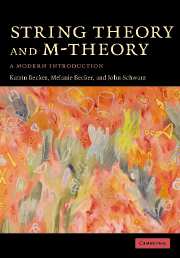Book contents
- Frontmatter
- Contents
- Preface
- 1 Introduction
- 2 The bosonic string
- 3 Conformal field theory and string interactions
- 4 Strings with world-sheet supersymmetry
- 5 Strings with space-time supersymmetry
- 6 T-duality and D-branes
- 7 The heterotic string
- 8 M-theory and string duality
- 9 String geometry
- 10 Flux compactifications
- 11 Black holes in string theory
- 12 Gauge theory/string theory dualities
- Bibliographic discussion
- Bibliography
- Index
3 - Conformal field theory and string interactions
Published online by Cambridge University Press: 05 September 2012
- Frontmatter
- Contents
- Preface
- 1 Introduction
- 2 The bosonic string
- 3 Conformal field theory and string interactions
- 4 Strings with world-sheet supersymmetry
- 5 Strings with space-time supersymmetry
- 6 T-duality and D-branes
- 7 The heterotic string
- 8 M-theory and string duality
- 9 String geometry
- 10 Flux compactifications
- 11 Black holes in string theory
- 12 Gauge theory/string theory dualities
- Bibliographic discussion
- Bibliography
- Index
Summary
The previous chapter described the free bosonic string in Minkowski space-time. It was argued that consistency requires the dimension of space-time to be D = 26 (25 space and one time). Even then, there is a tachyon problem. When interactions are included, this theory might not have a stable vacuum. The justification for studying the bosonic string theory, despite its deficiencies, is that it is a good warm-up exercise before tackling more interesting theories that do have stable vacua. This chapter continues the study of the bosonic string theory, covering a lot of ground rather concisely.
One important issue concerns the possibilities for introducing more general backgrounds than flat 26-dimensional Minkowski space-time. Another concerns the development of techniques for describing interactions and computing scattering amplitudes in perturbation theory. We also discuss a quantum field theory of strings. In this approach field operators create and destroy entire strings. All of these topics exploit the conformal symmetry of the world-sheet theory, using the techniques of conformal field theory (CFT). Therefore, this chapter begins with an overview of that subject.
Conformal field theory
Until now it has been assumed that the string world sheet has a Lorentzian signature metric, since this choice is appropriate for a physically evolving string. However, it is extremely convenient to make a Wick rotation Τ → – iΤ, so as to obtain a world sheet with Euclidean signature, and thereby make the world-sheet metric hαβ positive definite.
- Type
- Chapter
- Information
- String Theory and M-TheoryA Modern Introduction, pp. 58 - 108Publisher: Cambridge University PressPrint publication year: 2006

